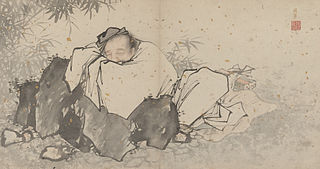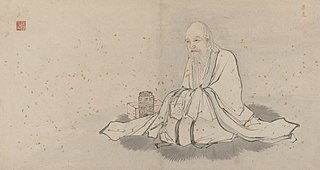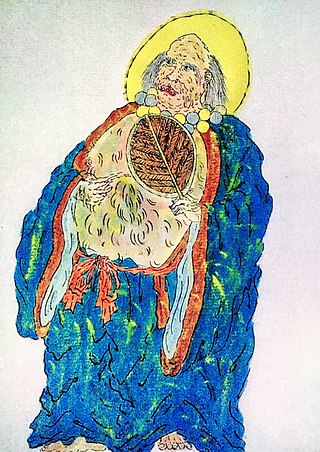
Taoism or Daoism is a diverse philosophical and religious tradition indigenous to China, emphasizing harmony with the Tao 道. With a range of meaning in Chinese philosophy, translations of Tao include 'way', 'road', 'path', or 'technique', generally understood in the Taoist sense as an enigmatic process of transformation ultimately underlying reality. Taoist thought has informed the development of various practices within the Taoist tradition and beyond, including forms of meditation, astrology, qigong, feng shui, and internal alchemy. A common goal of Taoist practice is self-cultivation, a deeper appreciation of the Tao, and more harmonious existence. Taoist ethics vary, but generally emphasize such virtues as effortless action, naturalness, simplicity, and the three treasures of compassion, frugality, and humility.

Cao Guojiu, literally Imperial Brother-in-law Cao, is a Chinese mythological figure and one of the Eight Immortals in the Taoist pantheon. His real name was Cao Yi while his courtesy name was Jingxiu, and he was better known to his contemporaries as Cao Jingxiu.

Lan Caihe is a Chinese mythological figure, and one of the Eight Immortals in the Taoist pantheon. His presence in this group makes Lan one of the more familiar of the hundreds of other Taoist immortals. Lan Caihe is the only one of the Eight Immortals whose gender is ambiguous. Lan is not generally thought to be based on a historical person, but is traditionally said to have been born sometime during the Tang dynasty, and lived as a homeless street entertainer, who wandered all over China, singing philosophical songs. Stories vary about how Lan attained immortality and became one of the Eight Immortals. Lan's emblem is a basket of flowers, and so this immortal is considered the patron of florists and gardeners.

Lü Dongbin is a legendary Chinese scholar and poet who lived during the Tang dynasty whose lifetime supposedly spanned two hundred and twenty years. Elevated to the status of an immortal in the Chinese cultural sphere by Daoists, he is one of the most widely known of the group of deities known as the Eight Immortals. Lü is also a historical figure and mentioned in the official history book History of Song. He is widely considered to be one of the earliest masters of neidan, or internal alchemy. He is also depicted in art dressed as a scholar carrying a sword to dispel evil spirits.

Han Xiangzi, courtesy name Qingfu or Beizhu, is a Chinese mythological figure and one of the Eight Immortals in the Taoist pantheon. He studied Taoist magical arts under the tutelage of Lü Dongbin, another of the Eight Immortals. Han Xiangzi is often depicted carrying a dizi, so he is also regarded as the patron deity of flutists. He is also believed to be the composer of the Taoist musical piece Tian Hua Yin (天花引).

Zhang Guo, better known as Zhang Guolao, is a Chinese mythological figure and one of the Eight Immortals in the Taoist pantheon. Among the Eight Immortals, Zhang Guolao, Zhongli Quan and Lü Yan are the only ones who appear in historical records as genuine figures in society at specific times and places. His existence is said to have begun around the middle or end of the 7th century, and ended approximately in the middle of the 8th. The epithet "Lao" added at the end of his name means "old".

Zhongli Quan, courtesy name Jidao, is a Chinese mythological figure and one of the Eight Immortals in the Taoist pantheon. He is also known as Han Zhongli because he was said to have been born in the Han dynasty. In legend, he holds a peach and wields a large feather fan which can resurrect the dead and transform stones into silver or gold.

The Legend of the White Snake is a Chinese legend centered around a romance between a man named Xu Xian and a female snake spirit named Bai Suzhen. It is counted as one of China's Four Great Folktales, the others being Lady Meng Jiang, Butterfly Lovers, and The Cowherd and the Weaver Girl.

The Sanxing are the gods of the three celestial bodies considered essential in Chinese astrology and mythology: Jupiter, Ursa Major, and Canopus. Fu, Lu, and Shou, or Cai, Zi and Shou (財子壽) are also the embodiments of Fortune (Fu), presiding over the planet Jupiter, Prosperity (Lu), presiding over Mizar, and Longevity (Shou), presiding over Canopus. They have emerged from Chinese folk religion. Their iconic representation as three, old, bearded, wise men dates back to the Ming dynasty, when the gods of the three stars were represented in human form for the first time. They are sometimes identified with other deities of the Chinese religion or of Taoism.

The microcosmic orbit (小周天), also known as the Self Winding Wheel of the Law, is a Taoist qigong energy cultivation technique. It involves deep breathing exercises in conjunction with meditation and concentration techniques which aim to develop the flow of qi along certain pathways of energy in the human body which may be familiar to those who are studying traditional Chinese medicine, qigong, tai chi, Neidan and Chinese alchemy. The exercise can be performed usually at first in a sitting position, but it can also be practiced standing as in Zhan zhuang or with movements included as with tai chi.

A xian is any manner of immortal, mythical being within the Taoist pantheon or Chinese folklore. Xian has often been translated into English as "immortal".

Xuanwu or Xuandi, also known as Zhenwu or Zhenwudadi, is a revered deity in Chinese religion, one of the higher-ranking deities in Taoism. He is revered as a powerful god, able to control the elements and capable of great magic. He is identified as the god of the north Heidi and is particularly revered by martial artists. He is the patron god of Hebei, Henan, Manchuria and Mongolia. As some Han Chinese migrated into the south from Hebei and Henan during the Tang-Song era, Xuanwu is also widely revered in the Guangdong, Guangxi and Fujian provinces, as well as among the overseas diaspora.

Cranes are an important motif in Chinese mythology. There are various myths involving cranes, and in Chinese mythology cranes are generally symbolically connected with the idea of longevity. In China, the crane mythology is associated with the divine bird worship in the animal totemism; cranes have a spiritual meaning where they are a form of divine bird which travels between heaven and man's world. Cranes regularly appear in Chinese arts such as paintings, tapestry, and decorative arts; they are also often depicted carrying the souls of the deceased to heaven. The crane is the second most important bird after the fenghuang, the symbol of the empress, in China.
Bai Mudan, also romanized as Pai Mu-tan, is a character from Chinese mythology. She is described as the most beautiful courtesan in the city of Luoyang and a reincarnation of the Peony fairy.

Liu Haichan was a Daoist xian who was a patriarch of the Quanzhen School, and a master of neidan "internal alchemy" techniques. Liu Haichan is associated with other Daoist transcendents, especially Zhongli Quan and Lü Dongbin, two of the Eight Immortals. Traditional Chinese and Japanese art frequently represents Liu with a string of square-holed cash coins and a mythical three-legged chanchu. In the present day, it is called the Jin Chan (金蟾), literally meaning "Money Toad", and Liu Haichan is considered an embodiment of Caishen, the God of Wealth.
Taoist art relates to the Taoist philosophy and narratives of Lao-tzu that promote "living simply and honestly and in harmony with nature."

Drunken boxing also known as Drunken Fist, is a general name for various styles of Chinese martial arts that imitate the movements of a drunk person. It is an ancient style and its origins are mainly traced back to the Buddhist and Daoist religious communities. The Buddhist style is related to the Shaolin temple while the Daoist style is based on the Daoist tale of the drunken Eight Immortals. Zui quan has the most unusual body movements among all styles of Chinese martial arts. Hitting, grappling, locking, dodging, feinting, ground and aerial fighting and all other sophisticated methods of combat are incorporated.

Barefoot Immortal, also known as Barefoot Master, is a Taoist deity in Chinese religion. He is known for his numerous appearances in Chinese operas and Chinese ancient literature, such as Journey to the West and Outlaws of the Marsh. The ancient images and ceramic works that people found about the conception of the appearance of Barefoot Immortal demonstrate that in the minds of most people, Barefoot Immortal is a kind god who always has a gracious smile on his face. Never wearing any shoes and having a half bald head are his unique marks and looks. There are several stories and legends about Barefoot Immortal that have become the widely known classical folk oral literature in China. His original name was Liu Hai before he was widely known as Barefoot Immortal and Liu Cao.

Taoist coin charms, or Daoist coin charms are a family of categories of Chinese and Vietnamese numismatic charms that incorporate elements of the Taoist religion. Taoist coin charms come in various shapes, sizes, and formats and can contain inscriptions or wholly pictorial designs. While a large number of Taoist coin charms have their inscriptions written in traditional Chinese characters, a subset of Taoist coin charms have inscriptions written in Taoist "magic" writing. In these countries similar numismatic charms existed for Buddhist and Confucianism, and at times Taoist coin charms would also incorporate symbolism from these other religions.

Xiaotian Quan is a Chinese mythological beast and companion of the Chinese god Erlang Shen. Depicted as a black dog, it assists Erlang Shen in battle by using its powerful bite and howl to attack, maul, or subdue demons. Xiaotian Quan appears in Journey to the West, Fengshen Yanyi, and other legends about Erlang Shen, such as Lotus Lantern and several Chinese folktales.
























